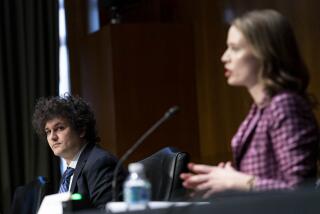They Freeze Death if Not Taxes : Cryonics: Freezing bodies for later, uh, reanimation gains popularity. But resurrection is not without complications.
- Share via
To date, 26 people have been cryonically suspended--frozen for the future--in the United States.
As it happens, 24 of them are in California, where the urge to live forever is beginning to look like a serious business.
The numbers are still tiny. And cryonics, an ad hoc science that was born with the icy suspension of a Glendale physician in 1967, still faces some daunting questions about its practicality and legal status.
After 23 years on the fringe, however, cryonics is clearly evolving from cult phenomenon into California’s latest--and perhaps most troubled--growth industry.
Membership in cryonics societies is rising sharply, thanks partly to publicity from a cryonics-related homicide investigation in Riverside three years ago and from the more recent request by a Silicon Valley mathematician to be frozen before his death. (Cryonicists hope to preserve themselves until science can find a way to revive them.)
At Riverside’s Alcor Foundation, for instance, membership has tripled to 590 since 1987. “1990 has blown us away. . . . If we keep going at anywhere near this rate, things are going to change radically around here,” says Alcor President Carlos Mondragon.
The sign-up boom--and the prospect that some groups will receive multimillion-dollar inheritances as the first generation of aging cryonics advocates begins to die--has sparked entrepreneurial vigor, as well as new problems, in the field that itself nearly expired in 1976. That’s when the Cryonics Society of California suffered financial collapse and several bodies were allowed to thaw.
Some new-wave cryonicists are unabashedly commercializing their activities in the belief that cryonics, like the biotechnology and computer industries, will achieve key technological breakthroughs only when big investors begin to smell profit in it.
“Once people found out you could make money using genetic technology, the thing just steamrolled. . . . Now, the commercialization of cryonics is occurring. The companies are beginning to amass respectable capital,” says Paul Segall, a Berkeley-based medical researcher.
Last year, he helped found Cryomedical Sciences Inc., a publicly traded company that is seeking medical applications for organ-freezing techniques developed by cryonics enthusiasts like himself.
Others are grappling with some weird questions of personal finance that arise when, largely outside conventional legal structures, you try to take your money with you. “If you think (cryonics) might work, the question is not only will you be restored in the future, but will you have any resources at that time,” explains 51-year-old cryonics activist Saul Kent. In 1987, Kent became embroiled in a homicide investigation after his mother Dora’s head was frozen--the preferred term for heads-only preservation is “neurosuspension”--and the Riverside County coroner determined that her body was suffused with a lethal dose of barbiturate.
(It is cheaper to preserve just a head, and some cryonicists believe it advantageous, since they expect science to devise new bodies by cloning or another technique in the future.)
Officials of Alcor, which performed the suspension, maintained that the drug was administered after death, and the investigation was eventually suspended.
Kent, who acknowledges that the resulting publicity boosted Alcor’s membership, is now preoccupied with developing IRAs: individual reanimation accounts. They promise investors fanciful returns (see chart) in 100 years or more on money that will be moved, through a Liechtenstein foundation, to a Swiss bank. And they are only the latest twist in a business that is virtually unregulated because authorities have been reluctant to put an implied stamp of approval on what may prove to be just a silly attempt to cheat death.
In fact, cryonics has been in legal limbo since state health officers two years ago stopped issuing death certificates for frozen corpses and asked the district attorney in Riverside to prosecute Alcor for disposing of human remains without a license. Alcor sued the state health department and has continued to perform suspensions--arguing that it would seek a cryonics license if any state agency offered one. Meanwhile, prosecutors have withheld action pending a decision on the matter from a Los Angeles Superior Court judge later this month.
“There’s a hole in the law,” concedes California Deputy Atty. Gen. Y. Tammy Chung, who is handling the state’s defense against the Alcor suit.
Though generally wary of authority, cryonicists have often been even warier of each other since the 1976 meltdown, known among initiates as the “Chatsworth incident.”
In the midst of a financial debacle, four bodies maintained at a Chatsworth storage facility were allowed to thaw, and a Los Angeles jury eventually entered a $1-million fraud award against CSC and its companion Cryonic Interment Inc., both now defunct.
That helped to persuade cryonics advocates that nothing--except, perhaps, body-damaging autopsies requested by nosy insurance examiners--was to be feared more than financial instability.
Many cryonicists now believe that the prospect of healthy, long-term profits will be the best incentive for future generations to maintain their bodies across time. “I don’t think altruism alone will do it,” says Arthur Quaife, president of Trans-Time Inc., a commercial cryonics company that is housed in an industrial zone near the Oakland airport.
Trans-Time, small and closely held by Quaife and others, raised about $1 million in fresh capital last year by spinning off organ-freezing technology to Cryomedical Sciences in return for stock. Cryomedical, based in Bethesda, Md., has no significant sales now. But its backers envision enormous profits if it can find a way to chill human organs for transplant.
Trans-Time insiders, meanwhile, say their company contemplates further spin-offs, or even a public stock sale of its own, to raise capital for new quarters, among other things.
According to Quaife, the company has made a small profit from fees for its eight suspensions to date but still loses money on long-term maintenance. He hopes to remedy that situation as economies of scale, helped along lately by the lucrative sideline of freezing pets for up to $16,000 each, bring storage costs down.
For the moment, preservation is a pricey proposition, largely because each “cryonaut” must set aside enough capital to pay for maintenance indefinitely out of interest alone.
Trans-Time’s current minimums for preservation arranged through the American Cryonics Society, a nonprofit group based in Cupertino, are $45,000 for “neuro”--head only--and $125,000 for a whole body. Alcor, working with a commercial adjunct called Cryovita Laboratories, provides similar services for $35,000 and $100,000, though prices at both facilities are scheduled to rise shortly.
Alternatively, a Canadian group will bury you in the Arctic for as little as $5,000, but many cryonics advocates believe the permafrost just isn’t cold enough for reliable long-term preservation. In Michigan, the Cryonics Institute is maintaining two bodies for less by relying heavily on volunteer labor, though some cryonics professionals are skeptical of their staying power. “You might as well pick a grave site,” says one.
In a whole body suspension, roughly 30% of the payment is applied to initial processing. The two facilities quibble about technique, but both use heart-lung resuscitators and other equipment to wash the blood out of a corpse and “perfuse” it with a fluid designed to protect organs against damage from extreme cold. Then the corpse is frozen at minus 320 degrees Fahrenheit in a container, or “dewar,” of liquid nitrogen.
(Cryonicists acknowledge that the suspension process creates problems of its own. “Between the temperature of the body (and) liquid nitrogen, we probably are causing extensive freezing damage,” says Dr. Avi Ben-Abraham, president of ACS. Generally, ice crystals inside of each cell expand, destroying membranes and other cell structures. Cryonicists hope perfusion with glucose and glycerol will limit such damage enough to permit eventual revival.)
The balance of the payment is deposited with Alcor, ACS or some other caretaker entity to be invested on the “patient’s” behalf at a rate presumably sufficient to beat inflation and cover costs of annual storage and liquid nitrogen replacements--$4,500 at Trans-Time and just $1,700 at apparently more efficient Alcor.
The preferred means of paying for the service is a life insurance policy naming the cryonics organization as beneficiary. Such policies pay off quickly with little danger of interference from frustrated would-be heirs and can be purchased by, say, a 30-year-old for only $60 a month or so.
But the insurance connection has also fed one of the more controversial financial practices in cryonics.
Until earlier this year, 21-year-old ACS--California’s oldest cryonics organization--maintained recruiting arrangements that gave exclusive sign-up rights in California to James Yount of Cupertino, and in the rest of the world to Irving Rand, of New York.
Both are insurance brokers, and each openly treated persons who inquired about cryonics as prospects for insurance policies. In addition, Rand charged paper work fees of up to $1,500 for processing new members, on top of the society’s $1,000 entry fee.
After a leadership shake-up that began last year, ACS severed its ties with Rand and scrapped the up-front charges. Yount became the organization’s secretary under the new regime and continues to recruit, but says he doesn’t sell insurance to any prospective member now that he’s an officer.
“I do not take as a client anyone who comes in via ACS. Because of conflict of interest, I do not,” he said, while conceding that the previous arrangements discouraged all but a few prospects from enlisting with ACS.
Rand says his arrangement was a fair trade for footing the cost of ACS’s “800” number. He also argues that cryonics will only come into its own when soft-headed enthusiasts, many of them Silicon valley professionals with science and technical background, become more comfortable with capitalist realities.
“Cryonics is my passion, insurance is my business,” he says.
Along with Segall and some others who drifted away from ACS after the internal shake-up, Rand earlier this year founded the International Cryonics Foundation, based in Stockton. Once again, he is in charge of recruiting and is currently approaching cemeteries and mortuaries, looking for alliances that will give cryonics added vitality.
Ironically, death itself is already boosting the societies, as first-generation advocates begin to “deanimate,” often having committed substantial estates to their organizations.
Alcor apparently reaped the first major bequest when television writer-producer Dick Clair (“The Carol Burnett Show”) died in 1988.
Clair left two wills, one of which named the foundation as his principal heir, and placed no restrictions on his bequest. After a costly legal battle with other would-be heirs, Alcor reached a settlement giving it TV show residuals of perhaps $2 million over 10 years, as well as about $500,000 cash and title to Clair’s North Hollywood home, valued at about $650,000.
For Alcor, it was enough to fund staff positions and equipment purchases that are the envy of its northern rivals. The next step will be to find seed money for a planned new facility, which is likely to become a major selling point as Alcor competes with ACS and Trans-Time for sign-ups.
At ACS, meanwhile, officers estimate that half of the group’s 102 suspension members have committed all their wealth, totaling tens of millions of dollars, for management by the society, which generally promises to invest the funds for research and patient care and to return any balance to the members upon “reanimation.”
While eager for fresh funds, cryonicists also fear the bequests will attract unscrupulous operators who might seize a society’s assets by purchasing a controlling number of memberships, or will trigger closer official scrutiny of the various groups’ finances.
“If we get up to more than one (suspension) a month,” says ACS Treasurer John Day, “the money will grow to the point where it will attract government interest.”
Cryonicists believe that legal scrutiny, if it comes, is likely to focus on the “rule against perpetuities,” a common law principle that strictly limits the duration of personal financial arrangements.
In short, you can’t control your money forever. But cryonicists keep trying.
At ACS, suspension customers have tried to sidestep the rule by establishing individual charitable trusts, which are not limited in duration. A key purpose of each trust is the maintenance and eventual reanimation of the cryonicist’s body--a charitable cause that even devotees believe will someday receive close examination by California’s attorney general, the “super-guardian” of all trusts in the state.
Alcor, founded as a nonprofit foundation in 1972 by a group of CSC dropouts, simply executes a contract to care for its bodies indefinitely, and pools its care funds for management by an investment committee appointed by the foundation’s board. The preferred investment of the moment is U.S. Treasury bills, according to 34-year-old Mondragon, a former financial analyst who became Alcor’s chief executive in 1989.
Even some close Alcor allies are less than satisfied with Alcor’s financial arrangements, however. “There’s nothing in those contracts that indicates you’re ever going to get a penny back--because they can’t do it” due to the rule against perpetuities and other strictures, says cryonicist Kent, one of the foundation’s most active members.
Kent, not surprisingly, recommends investment in his foundation, which promises to place the investor’s funds with the Union Bank of Switzerland in Zurich, because of its presumed solidity, and to hold it, forever if necessary, under Liechtenstein law. The foundation has chosen the tiny European principality because, according to Kent’s research, it numbers with the Turk and Caicos Islands in the Caribbean and Nauru in the South Pacific as one of three places where the rule against perpetuities doesn’t hold sway.
“I don’t think that’s really necessary,” UCLA law professor Robert McGowan says of the Liechtenstein ploy. McGowan, who is not associated with any cryonics organization, points out that South Dakota and Wisconsin, for instance, have virtually abolished the rule and are more easily reached by contributors trying to enforce their own rights.
In any case, Kent acknowledges that he hasn’t worked out the tax consequences of a bequest to oneself--a problem that could be considerable if a reanimated investor were to awaken with, as he predicts, billions of dollars in accumulated interest.
“You’ll come back to tax problems. The government’s going to say, ‘That’s very nice--here’s what you owe,’ ” warns Lance Brofman, a New York municipal bond fund manager.
Brofman offers a solution, however: His own Cryonic Asset Trust, which he plans to market in association with the fledgling ICF. He claims already to have contacted the New York state legislature about an exemption from the rule against perpetuities, and figures that tax-free municipals will prove the best investment for a future that may test the staying power of even the biggest industrial concerns.
“Most likely, the State of California, the City of Los Angeles, is going to be around 500 years from now,” he advises. “But IBM . . . who knows?”
More to Read
Inside the business of entertainment
The Wide Shot brings you news, analysis and insights on everything from streaming wars to production — and what it all means for the future.
You may occasionally receive promotional content from the Los Angeles Times.










